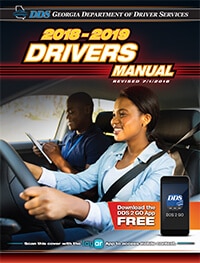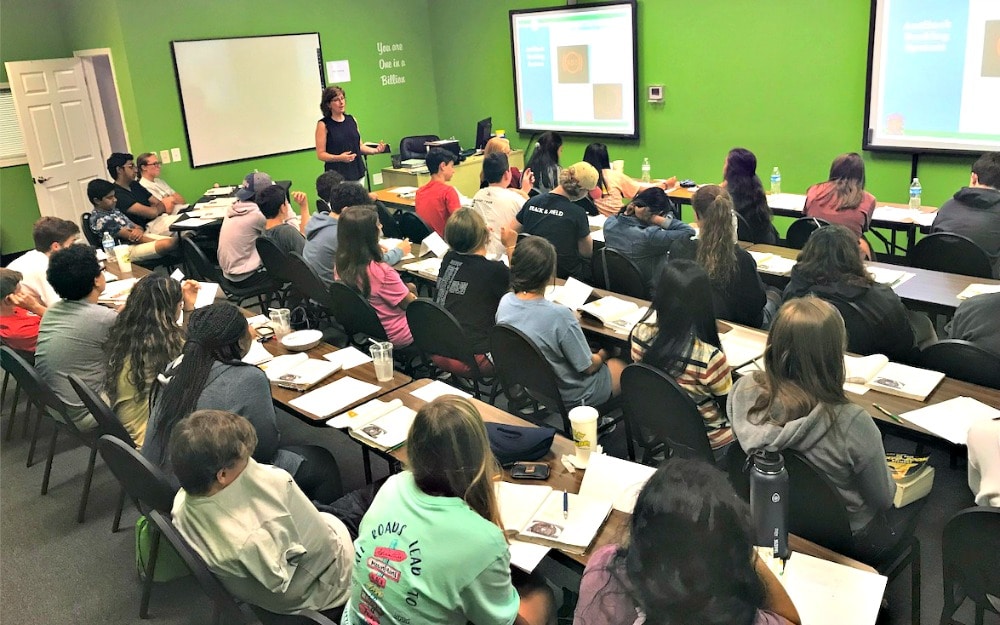Georgia learners permit: Requirements and 5 steps to success

Are you ready to get your Georgia learners permit? Are you 15 and ready to hit the road? If so, congratulations! Getting a Georgia learners permit is quite a milestone. It means you’re one step closer to getting that coveted driver’s license.
Where should you start and what are the requirements to get a Georgia learners permit? Everything you need to know is right here, so keep reading.
Georgia Learners Permit Requirements
Requirements for a learners permit varies from state to state. In Georgia, applicants must be at least 15 years of age. In addition, you must pass a vision and a knowledge exam.
According to Georgia DDS, the knowledge exam consists of two tests – the road rules test and the road signs test. The applicant must pass each test. A minimum score of 15 out of 20 correct answers, on each test, is required to pass.
Georgia Learners Permit Step #1:
Study the official Georgia Driver’s Manual
The Georgia Driver’s Manual is your go-to for all things about driving. It can be found at any Georgia DDS office. You can also study and read the manual online by clicking here.
Regard this manual as your go-to guide for everything from A-Z that you need to know to pass the learner’s permit test. Once you have your Driver’s Manual, read the entire book and study the information like you would for a school test.
Highlight important points and then re-read them a second time. The info from the Manual will turn into questions on your test, so you want to be as familiar with it as possible.
Georgia Learners Permit Step #2:
Take Drivers Ed
In Georgia, teens can take a Drivers Ed class when they’re 14-years-old. Joshua’s Law requires the 30-hour class for teens that want to get a license at the age of 16 or 17.
Be careful when choosing a driving school. First, make sure it specializes in teaching teens how to drive. If it’s endorsed by AAA, than even better! However, not all driving schools are created equal, so be sure to read online reviews and do your research to choose the best one.
By taking the Drivers Ed class early, you will learn about road rules and more. It will actually help you pass the Georgia learners permit test because the material you need to know will be fresh in your mind. It’s not necessary to take the class before the permit test, but it can help ensure success.
Georgia Learners Permit Step #3:
Take a few practice tests
Once you’ve taken a Drivers Ed class or read and studied the Georgia Driver’s Manual, then it’s time to take a few practice tests online. This will help you prepare and will allow you to see if you fully understand the information in your manual.
Georgia learners permit practice tests are available online, so try to take and pass at least three. Click here to take a practice test. All information necessary to pass the test is included in the Georgia Drivers Manual. The practice tests will provide a good insight into the type of questions that will be asked.
In addition to reading the Georgia Drivers Manual, Quizlet.com offers great online flashcards to help study for the Georgia Permit Test.
Example of a Georgia learners permit practice test
Take the practice permit test below to test your driving knowledge. However, keep in mind that the actual questions will be different on the actual exam.
Water on the road can cause a vehicle to hydroplane. Your car may hydroplane at speeds as low as:
- A. 45 miles per hour
- B. 35 miles per hour
- C. 40 miles per hour
If, while driving, a tire suddenly blows out, you should:
- A. Grip the steering wheel firmly, slow down, and exit from the traffic lanes.
- B. Pump the brakes rapidly.
- C. rake hard and steer toward the right edge of the roadway.
What is the proper way to enter an expressway from the entrance ramp?
- A. Go down the ramp and cross over to the traffic lane as soon as possible.
- B. Use the acceleration lane to blend into the traffic.
- C. Go down to the bottom of the ramp and stop until it is safe to enter the expressway.
The maximum speed limit on a rural Interstate highway is:
- A. 60 miles per hour
- B. 70 miles per hour
- C. 55 miles per hour
Georgia’s Move-Over Law was passed because:
- A. Emergency vehicles are visible, so they are easily seen.
- B. Emergency vehicles are less vulnerable to crashes due to their lights and sirens.
- C. Emergency vehicles parked beside a highway are vulnerable to crashes, even when their emergency lights are flashing.
If you are involved in an accident, one of the immediate requirements is to:
- A. Render aid to the injured.
- B. Notify your insurance agent.
- C. Notify the Secretary of State’s office.
You are driving behind a motorcycle and want to pass. You must:
- A. Stay in the right lane as much as possible, because the motorcycle is small and doesn’t use the entire lane.
- B. Blow the horn to make the motorcycle move onto the shoulder so that you can pass.
- C. Have your vehicle entirely in the left lane before and during the pass.
A conviction for unlawful passing of a school bus will result in a total of ____ points on your Georgia driving record.
- A. 6
- B. 4
- C. 2
Streets and highways are most slippery:
- A. When it has been raining hard for several hours.
- B. When they are clean and dry.
- C. Just after it starts to rain.
When driving behind another vehicle at night, you should:
- A. Keep your headlights on low beam.
- B. Use your high beam headlights until you are within 10 feet of the vehicle ahead.
- C. Use your high beam headlights.
Below are the correct answers to the above questions.
- B (35 miles per hour)
- A (Grip the steering wheel firmly, slow down, and exit from the traffic lanes)
- B (Use the acceleration lane to blend into the traffic)
- B (70 miles per hour)
- C (Emergency vehicles parked beside a highway are vulnerable to crashes, even when their emergency lights are flashing)
- A (Render aid to the injured)
- C (Have your vehicle entirely in the left lane before and during the pass)
- A (6 points)
- C (Just after it starts to rain)
- A (Keep your headlights on low beam)
Georgia learners permit Step #4:
Gather the required documents
After successfully passing a few practice tests, it’s time to head to the DDS, right? Well, not exactly. First, you and your parents must gather six important documents to take with you.
These documents include:
- 1 proof of identity (passport, birth certificate)
- 1 proof of social security number (W-2, social security card)
- 2 proofs of residence (utility bill, financial statement, etc.)
- 1 proof of US citizenship, and a Georgia Certificate of Attendance form notarized by your high school. You must request this form from your school office and they often request 3-5 days to get it for you. The Certificate of Attendance is valid for 30 days or from May-August in the summer.
Head to the Georgia DDS website for more information about required documents.
Georgia learners permit Step #5:
Take and pass the test
You have prepared for the exam, taken the practice tests and gathered your required documents. So, what’s next? Yep, it’s now time to head to a DDS office to take your Learner’s Permit Test. The DDS offices administer written tests Tuesday through Saturday. Wednesday and Thursday are typically less busy than Tuesday, Friday or Saturday. Click here to find a location close to your home.
Passed the Georgia learners permit test? What’s next?
Woo hoo! You have your Georgia learners permit, so you’re ready to hit the road, right? Nope, not so fast, speedy. With a learners permit, you have permission to drive ONLY with a passenger who is at least 21 years old and has an unexpired Class C driver’s license.
In order to get your actual driver’s license at 16 or 17 years of age, Georgia Law requires that you take an approved Driver’s Ed course, like the one offered at Drive Smart Georgia. Also, you must have 40 hours of driving experience (6 at night), plus pass the road test, which can be taken no sooner than one year and one day after getting your Learner’s permit.
This might all sound very daunting, but Joshua’s Law was passed in Georgia to help keep new drivers safe. Auto accidents remains the #1 cause of death among teens, so it’s critical to follow the requirements to the tee, not just because it’s the law, but because they could quite possibly save your life.
Parents must stay involved!
So, your baby has a Georgia learners permit and can begin to drive. That’s quite a milestone! Pat yourself on the back, but remember that teen drivers face dangerous situations each and every day, especially in the first year.
When asked what one piece of advice the founder of Joshua’s Law could offer, Mr. Alan Brown answers…
Remember who’s in charge. You’re the parent. If you don’t think your child is ready, pull the keys.
If your newly permitted driver is ready to get behind the wheel, parents should take a deep breath and stay involved every mile of the learning journey. It’s much more important to teach lifelong good driving skills than just those needed just to pass the test.
CLICK HERE to get our free newsletter and teen driving tips for parents.
Related articles:
- Advice for nervous parents of new teen drivers
- New apps help worried parents track teen drivers
- What is Joshua’s Law? A guide for parents to limit teen driver dangers





